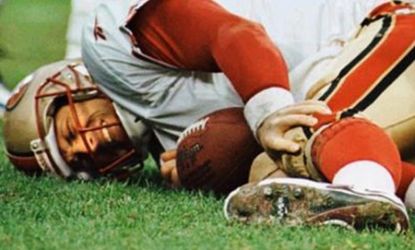Football's wounded gladiators
A new study found that concussions put NFL players at far greater risk of permanent brain damage. Don’t players care?

What happens in a concussion?
A concussion—from the Latin concutere, meaning to shake violently—results from a blow to the head so jarring that the brain crashes into the skull. In that internal collision, the gray matter is temporarily compressed, like a rubber ball hitting a wall. Nerve impulses get temporarily scrambled, as the thin tendrils called axons that carry signals among brain cells stretch and break. If the blow is bad enough, the person can lose consciousness, but even when he doesn’t, the immediate result is nausea, slurred speech, grogginess, and disorientation. Some 300,000 concussions occur annually in all U.S. sports, with football—high school, college, and professional—accounting for about a third of them. “It’s happened to me several times,” says Steven Jackson, a St. Louis Rams tailback. “Everything just starts shaking. Things just get dizzy, blurred.”
Are the players concerned?
Subscribe to The Week
Escape your echo chamber. Get the facts behind the news, plus analysis from multiple perspectives.

Sign up for The Week's Free Newsletters
From our morning news briefing to a weekly Good News Newsletter, get the best of The Week delivered directly to your inbox.
From our morning news briefing to a weekly Good News Newsletter, get the best of The Week delivered directly to your inbox.
In the macho culture of sports, players used to shrug off concussions; “getting your bell rung” or “getting dinged” was just seen as part of the game. But as evidence mounts that concussions can cause permanent damage, that attitude is changing. Three current NFL players, in fact, have agreed to posthumously donate their brains and spinal cord tissue to a Boston University Medical School program that studies the long-term effects of repeated concussions. “One of the most profound actions I can take personally,” says Arizona Cardinals receiver Sean Morey, “is to donate my brain to help ensure the safety and welfare of active, retired, and future athletes.” More than 150 retired athletes have also pledged their brains to science.
What caused the change in attitude?
Both anecdotal and scientific evidence. A University of Michigan study commissioned by the NFL found last month that retired NFL players suffer dementia, Alzheimer’s, and other memory-related diseases at much higher rates than the general population. About 1.9 percent of ex-players ages 39 through 49 suffered such diseases, or 19 times the national average. Among those over 50, the figure was 6.1 percent, or five times higher. “We know it’s real,” says retired New York Giants linebacker Harry Carson. “We deal with it every day.” Ted Johnson of the New England Patriots estimates he suffered 30 or more concussions during his playing career; he retired in 2005, when he could no longer concentrate during games. After he quit, he couldn’t remember appointments or people’s names, and he became depressed and irritable; his marriage fell apart. He got hooked on amphetamines and grew terrified of the outside world, locking himself in his apartment for days on end. “I don’t want anyone to end up like me,” he says.
What does the NFL say?
Sign up for Today's Best Articles in your inbox
A free daily email with the biggest news stories of the day – and the best features from TheWeek.com
“There are thousands of retired players who do not have memory problems,” says NFL spokesman Greg Aiello, contending that more research is needed. But previous studies have reached similar conclusions. The University of North Carolina has found that 15 percent of nearly 3,000 retired athletes surveyed reported that concussions had permanently affected their thinking and memory. Even more troubling, researchers found a very rare degenerative disease, chronic traumatic encephalopathy (CTE), in the brains of six former NFL players who all died by 50. One of them was Tom McHale, a retired lineman for the Tampa Bay Buccaneers, who died in 2008 at the age of 45 of an accidental overdose of oxycodone and cocaine, following extended bouts of joint pain, lethargy, and depression. Of the other retired players revealed by autopsies to have had CTE, two committed suicide, one died after accidentally shooting himself, and another died after leading police on a high-speed chase.
Do players know the risks?
Yes, but they still feel pressure to get back onto the field. “Who wants to be the guy who doesn’t want to go back in the game because I got a headache?” says Denver Broncos cornerback Andre Goodman. Many younger players emulate that machismo: Every fall, the nation’s 1.2 million high school football players suffer some 67,000 concussions, and nearly 41 percent of those affected return to the field too soon, under guidelines set by the American Academy of Neurology. Teenagers are especially vulnerable to “second-impact syndrome,” which occurs when a brain that’s had one concussion doesn’t get enough healing time before enduring another. The result is dangerous swelling that can lead to paralysis or death.
So what’s being done?
The NFL has mandated “baseline” tests of brain function for each
player, so that doctors and trainers can more accurately diagnose concussions in players who don’t lose consciousness. In May, Washington state passed a law forbidding young athletes who may have sustained a concussion from playing again without a certified medical provider’s approval. But most players are simply resigned to their fate. “When you sign that contract, you put yourself in harm’s way,” says
the Seattle Seahawks’ Lofa Tatupu. “It’s awful when it does happen. You keep your fingers crossed it doesn’t happen to you.”
Building a better helmet
Today’s padded, plastic football helmets, complete with cage-like face bars, are a far cry from the flimsy leather models of the game’s early days. A new model unveiled last year, the Xenith X1, is specifically designed to guard against concussions. The Xenith is lined with 18 small, disc-like thermoplastic air chambers that act as shock absorbers. When a player is struck, the chambers flatten under the impact, increasing the pressure inside them and slowing their compression. Because these chambers take more time to compress than traditional foam or gel-filled padding, the new helmet slows down the deceleration of the brain upon impact, reducing the force of a collision. The shock absorbers themselves are attached to a flexible cap that can be adjusted with a cable that runs through the helmet’s chin strap, allowing it to be adapted to the contours of one’s head. Despite its price tag of $350 per helmet, the Xenith is now worn by players at about 600 high schools and 200 colleges, and several NFL teams have placed orders.
For our coverage of Congressional hearings about player safety, see "Ban the NFL?"
Create an account with the same email registered to your subscription to unlock access.
-
 'A speaker courageous enough to stand up to the extremists in his own party'
'A speaker courageous enough to stand up to the extremists in his own party'Instant Opinion Opinion, comment and editorials of the day
By Harold Maass, The Week US Published
-
 How could the Supreme Court's Fischer v. US case impact the other Jan 6. trials including Trump's?
How could the Supreme Court's Fischer v. US case impact the other Jan 6. trials including Trump's?Today's Big Question A former Pennsylvania cop might hold the key to a major upheaval in how the courts treat the Capitol riot — and its alleged instigator
By Rafi Schwartz, The Week US Published
-
 Today's political cartoons - April 18, 2024
Today's political cartoons - April 18, 2024Cartoons Thursday's cartoons - impeachment Peanuts, record-breaking temperatures, and more
By The Week US Published